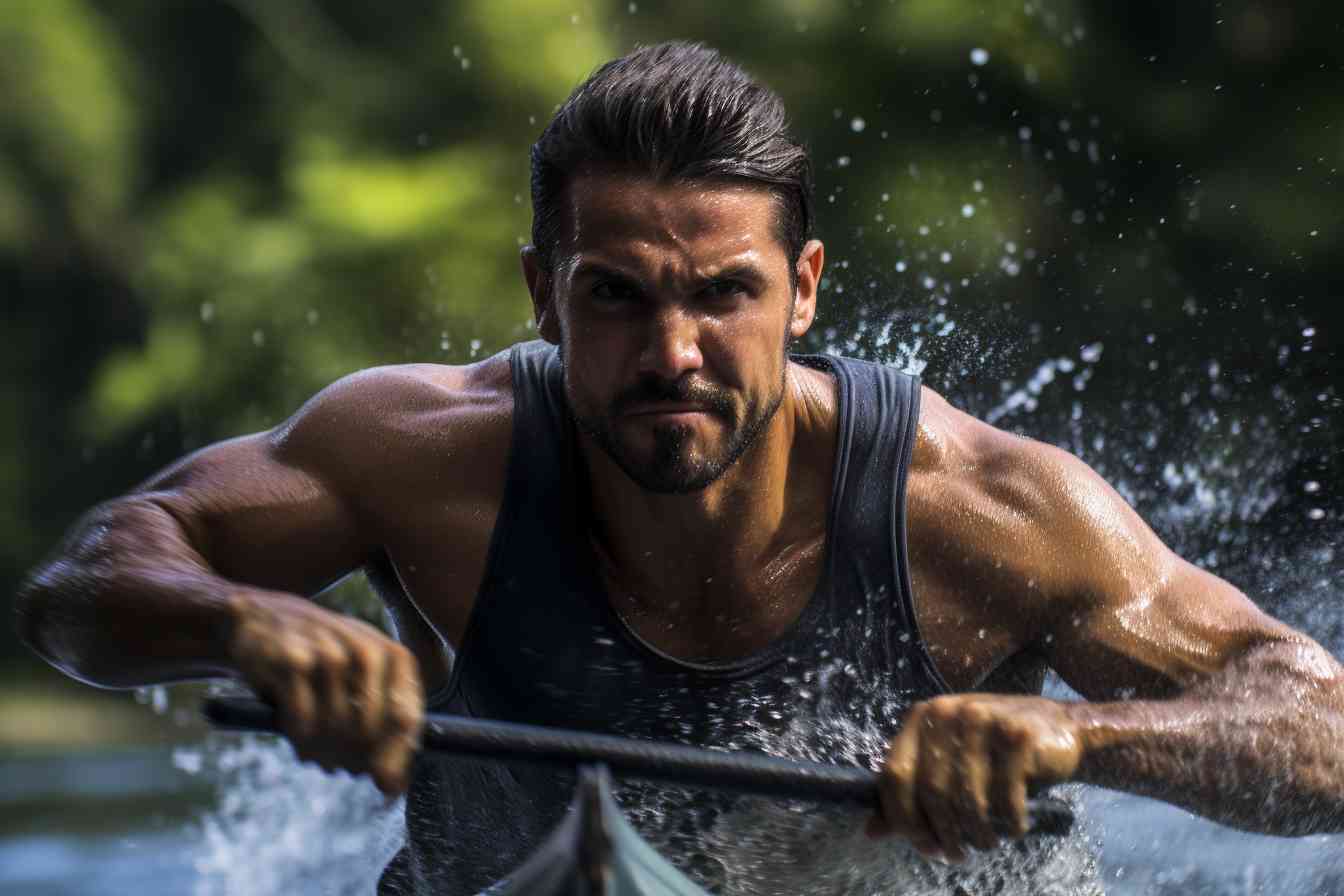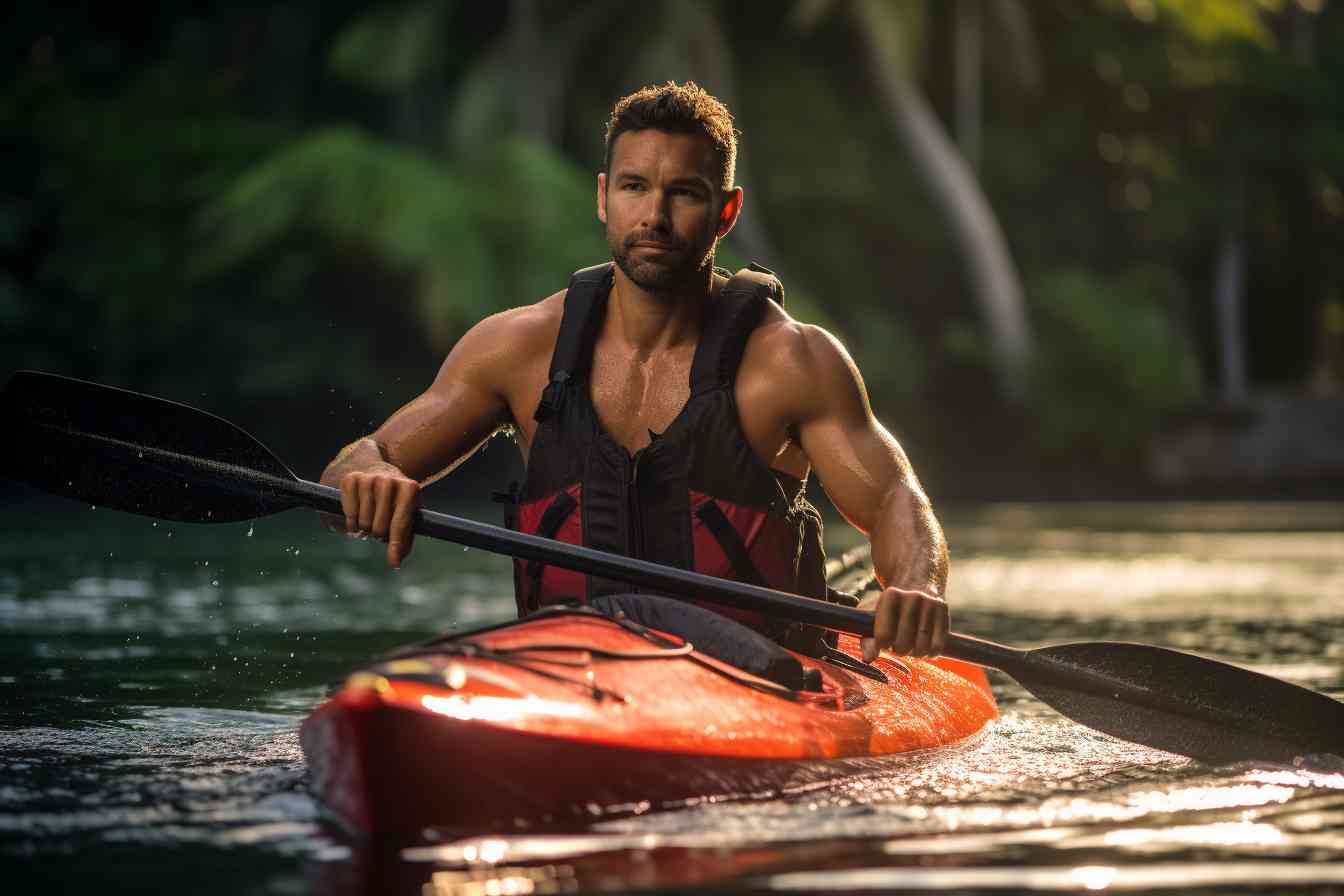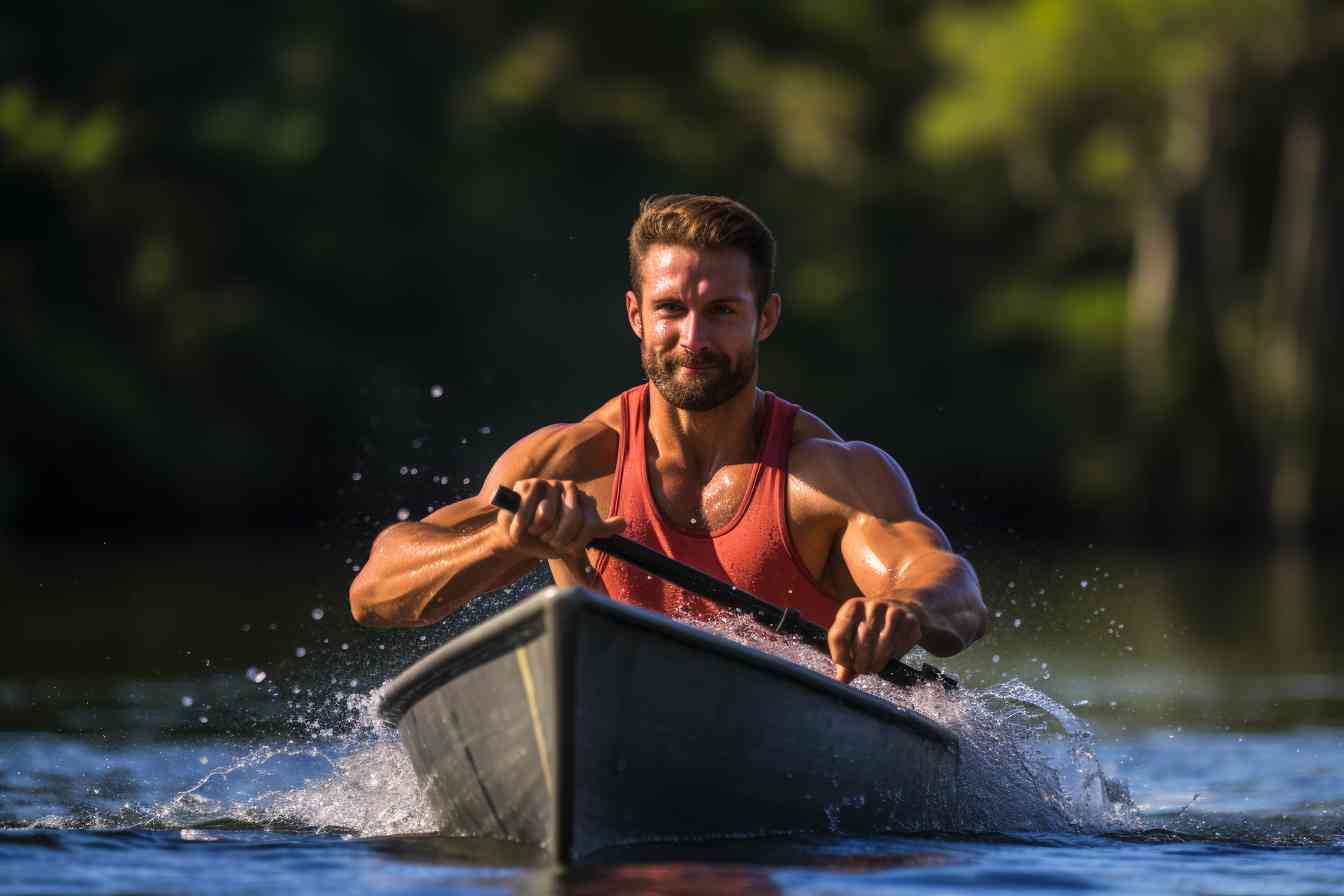Intro: What Muscles Does Kayaking Work

As someone who loves being on the water and navigating the powerful currents of Mother Nature, I can tell you – kayaking works more than just your arms. You may think it’s all in the upper body, but, boy, are you wrong!
Kayaking, my friends, is a full-body workout. It targets muscles from head to toe, testing your strength and endurance. Sounds amazing, doesn’t it? Kayaking is not just about paddling; it’s a delicate dance of movement requiring balance, power, and agility.
Let’s start with the shoulders. These bad boys bear the brunt of the load. Each forceful stroke of the paddle works your deltoids intensely. It’s like doing shoulder press reps, except you’re having a blast on the water!
Next on the list – the arms, both your biceps and triceps get a good workout. Pushing the paddle forward helps stress the triceps while pulling it back helps flex the biceps. Trust me; it’s an arm-toning exercise like no other.
Now, pay heed to your back. Your latissimus dorsi, referred to as the ‘lats’, are the large muscles in your back. These muscles are engaged with each paddle stroke, helping to pull the paddle through the water.
And, let’s not give the chest a miss. Every time you push the paddle through the water, you’re also working your pectoral muscles.
But kayaking isn’t just an upper-body workout – your legs, believe it or not, play a significant role too. A kayaker’s legs provide stability and control while balancing in the kayak. In fact, your hamstrings, quads, and calf muscles are in continuous action, stabilizing the body and maintaining balance.
Finally, the unsung heroes of kayaking – your core muscles. Both the abs and the lower back get a fantastic workout from maintaining balance and rotating the torso. It’s like a fun-filled session of Pilates on the water!
So, you asked what muscles does kayaking work? I would say, just about every muscle you can think of! Whether you’re a fitness fanatic looking for a new challenge or a nature lover in search of a serene escape, kayaking has got something for everyone. Now, put on your lifejacket, grab your paddle, and hit the water. Your muscles will thank you! Remember, every stroke is a step towards a healthier, fitter you.
Is Kayaking A Good Workout?

Absolutely, kayaking is a fantastic workout! I mean, it’s not just a fun way to enjoy the beauty of nature– it’s also good for your muscles and general fitness. Get this – when you’re out there on the water, you’re working a complex group of muscles. Believe me, you’re not just splashing around; you’re doing some serious exercise.
Consider the upper body strength you need for paddling. You’re employing your biceps, triceps, and your shoulder muscles to dig your paddle into the water and then pull it back. This action repeated over time really exercises these muscles and builds endurance. Now, that’s one heck of an arm workout. And the best part? It doesn’t feel like a chore – you’re having a blast while doing it!
But hey, it’s not just about the arms and shoulders. Don’t forget about your core muscles, which include your abs and back. Keeping your kayak stable requires a tremendous amount of core strength. You’re consistently engaging those muscles to maintain equilibrium, which in turn strengthens them.
So, to put it simply, yes, kayaking is quite the workout. It’s a full-body exercise that builds strength, endurance, and balance. It’s not only a fun outdoor activity, but also a fantastic way to stay fit. What more could you ask for?
Is Kayaking Good For Losing Belly Fat?

Well, lemme start by saying – absolutely it is! When you’re kayaking, it’s not just your arms and shoulders that get a vigorous workout; kayaking also works your core muscles very strenuously, and that includes your abdominals. The average person will burn between 300-500 calories per hour of kayaking, depending on intensity and individual metabolism. That means, if you’re using this as a form of exercise regularly, it can indeed help you lose belly fat.
Every time folks paddle, they engage their core muscles by twisting their upper body. As you rotate your torso and apply pressure to paddle, your obliques and other abs are engaged, toning your tummy muscles. .
So, if you’re thinking about losing that pesky belly fat, hopping onto a kayak might just be the thing for ya. It’s a fun and adventurous way to burn calories and strengthen your midsection. But remember, a healthy diet alongside regular exercise is the key to any effective weight loss journey, kayaking included.
Is kayaking a complete workout? Well, it can be. But don’t forget, it should be complemented with other forms of exercise, like cardio and strength training, for a well-rounded fitness routine. So go on, grab those paddles and dive into a healthier, active lifestyle. It’s not just a boat ride, it’s a journey towards a fitter you. Kayaking – it’s more than meets the eye!
What Is The Body Type Of A Kayaker?

So, what exactly is the body type of a kayaker, you might ask? Well, let me tell you – it’s quite a unique blend of strength, endurance, and agility. Kayaking involves a lot of upper body strength – it’s practically a full-on workout for your arms, shoulders, back, and core. You’ve got to have strong arms for those long strokes, not to mention a sturdy core to keep the kayak steady and maintain balance, right?
You’ve got to also remember that kayaking is not just about brute force – it’s about endurance too. The constant paddling requires cardiovascular fitness. It’s not like lifting weights, where you do a rep and then rest for a minute. It’s continuous, steady work. You’ve gotta keep the pace stable to reach the finish line. Hence, kayakers often possess well-toned bodies that are lean but muscular.
And of course, there’s the agility factor too. In situations where you need to quickly maneuver your kayak, good reflexes and agility play a vital role. The ability to shift your weight and adjust your balance instantly can be the difference between staying afloat or taking an unplanned dip in the water.
So, to sum it up, most kayakers have trim, athletic bodies with noticeable muscle definition, especially in the upper body. They display a robust blend of strength, stamina, and agility – a testament to the holistic physical challenge that kayaking provides.
One more thing, though. It’s essential to note that body types can vary widely among kayakers based on specific factors like kayaking styles, experience levels, and training routines. So, while there’s a typical kayaker’s body type, that doesn’t mean that everyone you see out there on the water will look the same. After all, part of what makes kayaking such an awesome sport is its inclusivity — no matter your shape or size, there’s a spot for you out there on the water.
Is Kayaking A Chest Workout?
Well, the truth of matter here is Kayaking doesn’t target your chest directly, but it does involve some chest muscles during paddling. It’s not really a chest workout similar to those you’d hit at the gym, like bench presses or push ups. But, believe me when I say it, your pecs do get engaged!
It’s just the way kayaking works—every stroke you take in the water involves a twist and pull motion that naturally engages your pectoral muscles. Now, listen up, while the pecs are not the primary movers in kayaking, they do play a key supportive role. They assist with the twisting motion and form part of the chain of muscles that transmit the power from your core to the paddle.
Let’s be clear here, if your primary goal is to build chest muscle, kayaking alone might not meet your expectations. But if you’re someone who’s lookin’ to improve overall fitness and strength, kayaking could be just the ticket. It’s a whole-body workout that improves cardiovascular health, tones muscles, and more importantly, gets you out in the great outdoors! So, even if it isn’t a chest workout in the classic sense, the holistic benefit this activity offers is pretty much unbeatable if you ask me! And come on, who doesn’t love a day out on the water, soaking in the sun and feeling the rhythm of the waves? It’s a blast, I tell ya!
Final Verdict
I’ve got to tell ya, kayaking isn’t just an opportunity for a splendid day out, it’s a heck of a workout too! Paddling engages a whole smorgasbord of muscles. Let’s dive right into it, shall we?
First off, it’s the upper body that’s doing the most work. Strong arm and shoulder muscles – your biceps, triceps and deltoids – are truly activated as you’re pulling and pushing that paddle. It’s the rotation of the torso, though, that’s the real powerhouse. This engages those core abdominal muscles and gives your back a good workout too. Who wouldn’t love a toned mid-section, right?
What’s more, the legs and lower body also play a key role when it comes to balance and stability. It might sound a tad counterintuitive since you’re sitting down in a kayak, but trust me on this one. Your lower body – particularly the hamstrings and glutes – gets its fair share of the action.
So there you have it. Kayaking, it turns out, is a comprehensive, full-body workout. Arms, core, back, and even legs – they’re all put through their paces. All this, while you’re out there on the water, basking in the beauty of the great outdoors. Now, isn’t that what you’d call a win-win, my friends?
Frequently Asked Questions
Q1: Which primary muscles are involved in kayaking?
The primary muscles involved in kayaking include your core muscles, back muscles (like the rhomboids and latissimus dorsi), shoulder muscles, and arm muscles including the biceps and triceps. Your leg muscles also get a good workout, though perhaps not as intense as your upper body.
Q2: How does kayaking work my core muscles?
Kayaking provides a great core workout because the twisting motion involved in each stroke engages your abs, obliques, and lower back muscles. These muscles stabilize your body in the kayak and power the rotation needed to paddle.
Q3: Does kayaking build shoulder strength?
Absolutely! The repetitive nature of the paddling motion really does strengthen your shoulders, particularly the deltoids. This is because they’re used extensively to move the paddle forward and backward.
Q4: Are my arm muscles targeted when I kayak?
Yes, they are. Both the biceps and triceps play a crucial role in each paddle stroke. Triceps extend the paddle forward for the stroke and biceps pull it back, gaining strength and endurance over time.
Q5: How does my back benefit from kayaking?
In kayaking, the latissimus dorsi and rhomboids in your back work heavily to power each stroke. This constant engagement helps strengthen and tone these muscles, improving your overall back strength.
Q6: Can kayaking help improve my leg strength?
Though kayaking is majorly an upper body workout, your legs certainly aren’t left out. They act as stabilizers and aid in turning and controlling the kayak. Regular kayaking can tone and strengthen your lower body as well.
Q7: Is kayaking a good workout for my chest muscles?
While kayaking doesn’t directly target the chest muscles like the pectorals, they do get indirectly involved during the paddle strokes. It’s not as intensive as an upper body workout, but it’s fair to say that kayaking does work them out to some extent.
Q8: What kind of muscle endurance can be developed with kayaking?
The repetitive movement of paddling can significantly develop muscle endurance, particularly in the arms, shoulders, and core. Over time, these muscles adapt to prolonged physical effort, improving your muscular endurance.
Q9: Is kayaking effective for full-body workouts?
Indeed, kayaking works several muscle groups across your body, from the arms and shoulders down to the core and legs. While the intensity may vary between muscle groups, it offers a solid full-body workout.
Q10: Does kayaking have cardiovascular benefits?
Yes, it does. Kayaking is a form of aerobic exercise, meant to raise the heart rate, improving cardiovascular health. This, combined with muscle strengthening, makes kayaking a fantastic exercise for overall body health.

